-
Countries
-
Data and Analysis
-
Special Focus
-
Crisis Responses

Contact
DTM Nigeria, iomnigeriadtm@iom.int
Language
English
Location
Nigeria
Period Covered
Nov 16 2023
Dec 18 2023
Activity
- Survey
- Displacement Solutions
- Return Intention
While many of the IDPs continued to be displaced for prolonged periods, there is a noticeable trend of increasing numbers of IDPs returning to their places of origin, as evidenced by Round 45 of DTM assessments (June 2023) identified 2,075,257 returnees in the region. Recognizing the growing number of returnees, the IOM Displacement Tracking Matrix (DTM), in collaboration with the Camp Coordination and Camp Management (CCCM)/Shelter and NFI and Protection sectors, including the National Emergency Management Agency (NEMA), National Bureau of Statistics (NBS), State Emergency Management Agency (SEMA), Nigeria Red Cross Society (NRCS), and other key partners deemed it necessary to assess the future intentions (within the next 12 months) of individuals in displacement areas to provide appropriate solution interventions. The DTM of the IOM Nigeria Mission, with the support of the partners, led the Intention Survey (IS) in Gombe State (including the other five states of the north-east) to assess IDPs who wish to return to their place of origin, locally integrate at their current location of displacement or relocate to another part of the state (LGA), within or outside the country.
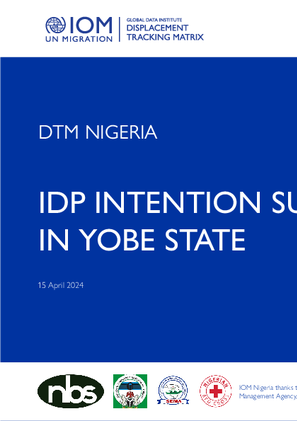
Contact
DTM Nigeria, iomnigeriadtm@iom.int
Language
English
Location
Nigeria
Period Covered
Nov 16 2023
Dec 18 2023
Activity
- Survey
- Displacement Solutions
- Return Intention
While many of the IDPs continued to be displaced for prolonged periods, there is a noticeable trend of increasing numbers of IDPs returning to their places of origin, as evidenced by Round 45 of DTM assessments (June 2023) identified 2,075,257 returnees in the region. Recognizing the growing number of returnees, the IOM Displacement Tracking Matrix (DTM), in collaboration with the Camp Coordination and Camp Management (CCCM)/Shelter and NFI and Protection sectors, including the National Emergency Management Agency (NEMA), National Bureau of Statistics (NBS), State Emergency Management Agency (SEMA), Nigeria Red Cross Society (NRCS), and other key partners deemed it necessary to assess the future intentions (within the next 12 months) of individuals in displacement areas to provide appropriate solution interventions. The DTM, with the support of the partners, led the Intention Survey (IS) in Yobe State (including the other five states of the north-east) to assess IDPs who wish to return to their place of origin, locally integrate at their current location of displacement or relocate to another part of the state (LGA), within or outside the country.
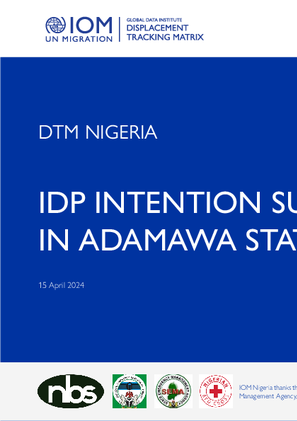
Contact
DTM Nigeria, iomnigeriadtm@iom.int
Language
English
Location
Nigeria
Period Covered
Nov 16 2023
Dec 18 2023
Activity
- Survey
- Displacement Solutions
- Return Intention
While many of the IDPs continued to be displaced for prolonged periods, there is a noticeable trend of increasing numbers of IDPs returning to their places of origin, as evidenced by Round 45 of DTM assessments (June 2023) identified 2,075,257 returnees in the region. Recognizing the growing number of returnees, the IOM Displacement Tracking Matrix (DTM), in collaboration with the Camp Coordination and Camp Management (CCCM) and Protection sectors, including the National Emergency Management Agency (NEMA), National Bureau of Statistics (NBS), State Emergency Management Agency (SEMA), Nigeria Red Cross Society (NRCS), and other key partners deemed it necessary to assess the future intentions (within the next 12 months) of individuals in displacement areas to provide appropriate solution interventions. The DTM of the IOM Nigeria Mission, with the support of the partners, led the Intention Survey (IS) in Adamawa State (including the other five states of the north-east) to assess IDPs who wish to return to their place of origin, locally integrate at their current location of displacement or relocate to another part of the state (LGA), within or outside the country.
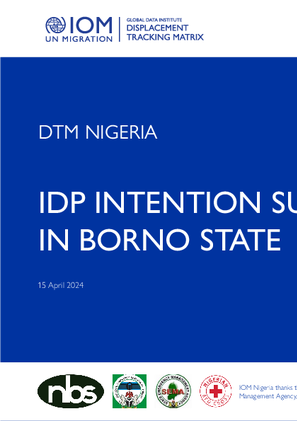
Contact
DTM Nigeria, iomnigeriadtm@iom.int
Language
English
Location
Nigeria
Period Covered
Nov 16 2023
Dec 18 2023
Activity
- Survey
- Return Intention
While many of the IDPs continued to be displaced for prolonged periods, there is a noticeable trend of increasing numbers of IDPs returning to their places of origin, as evidenced by Round 45 of DTM assessments (Sep 2023) identified 2,075,257 returnees in the region. Recognizing the growing number of returnees, the IOM Displacement Tracking Matrix (DTM), in collaboration with the Camp Coordination and Camp Management (CCCM) and Protection sectors, including the National Emergency Management Agency (NEMA), National Bureau of Statistics (NBS), State Emergency Management Agency (SEMA), the Nigerian Red Cross Society (NRCS), and other key partners deemed it necessary to assess the future intentions (within the next 12 months) of individuals in displacement areas to provide appropriate solution interventions. The DTM of the IOM Nigeria Mission, with the support of the partners, led the Intention Survey (IS) in Borno State (including the other five states of the north-east) through the BHA and ECHO fund. The aim of the IS was to assess IDPs who wish to return to their place of origin, locally integrate at their current location of displacement or relocate to another part of the state (LGA) or within the country.
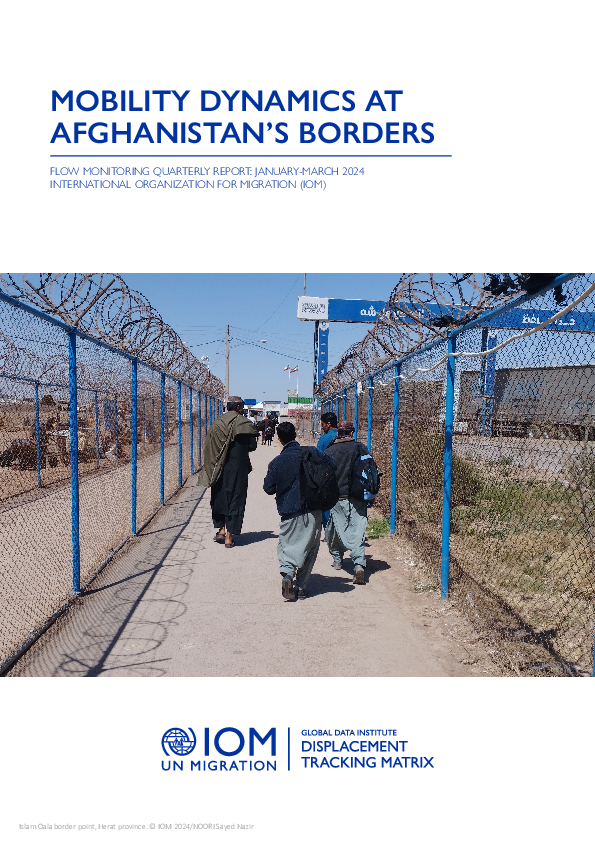
Contact
DTMAfghanistan@iom.int
Language
English
Location
Afghanistan
Period Covered
Jan 10 2024
Mar 31 2024
Activity
- Survey
- Flow Monitoring Survey
- Flow Monitoring
Over the course of decades marked by conflict, Afghanistan has experienced significant movement across its borders with neighboring countries the Islamic Republic of Iran and Pakistan. This movement, influenced by linguistic, geographical, and economic factors, has played a crucial role in shaping regional dynamics and fostering cultural ties between these countries. With 4.5 million Afghan nationals currently living in the Islamic Republic of Iran and 3.2 million currently living in Pakistan1, Afghan nationals not only seek economic opportunities, international protection and safety in these countries, but often visit family or participate in short-term travel for health and other reasons. In late 2023, policies and statements by officials in both the Islamic Republic of Iran and Pakistan called for the expulsion of undocumented foreigners, the majority of whom are Afghan nationals. Developments such as these recent policies targeting Afghan migrants have impacted movements to Afghanistan, as seen late last year when returns from Pakistan increased following the announcement of the “Illegal Foreigners’ Repatriation Plan (IFRP),” setting a deadline for unregistered or undocumented foreigners to voluntarily return to their countries or face deportation.
In response to these recent movements, IOM Afghanistan re-launched its DTM Flow Monitoring (FM) activity at the beginning of 2024 to provide critical insights into current mobility dynamics at Afghanistan’s borders. Flow Monitoring is designed to track the scale and characteristics of human mobility along the borders, including volume, intended destinations, reasons for movement, and intended lengths of stay. From January to the end of March 2024, DTM counted 567,411 individuals entering Afghanistan, 406,919 leaving Afghanistan, and interviewed 49,441 regarding their reasons for movement and intentions. The following report provides findings from DTM’s Flow Monitoring exercises for the first three months of data collection, examining trends and profiles among inflow and outflow groups to inform better targeted response mechanisms.
The report is structured in four sections. The first section, “Cumulative Flow Trends,” gives an overview of the total inflow and outflow numbers and trends between January and March. This section is linked to DTM’s Flow Monitoring Counting exercise (see details in “Methodology and Limitations”). The second and third sections, “Mobility Dynamics: The Islamic Republic of Iran” and “Mobility Dynamics: Pakistan” explore findings from interviews with people leaving and entering Afghanistan via borders with the Islamic Republic of Iran and with Pakistan, respectively. These sections are followed by “Mobility Dynamics: Conclusions” which summarizes and analyzes the findings from the interviews. These last three sections are linked to DTM’s Flow Monitoring Surveys exercise (see details in “Methodology and Limitations”).
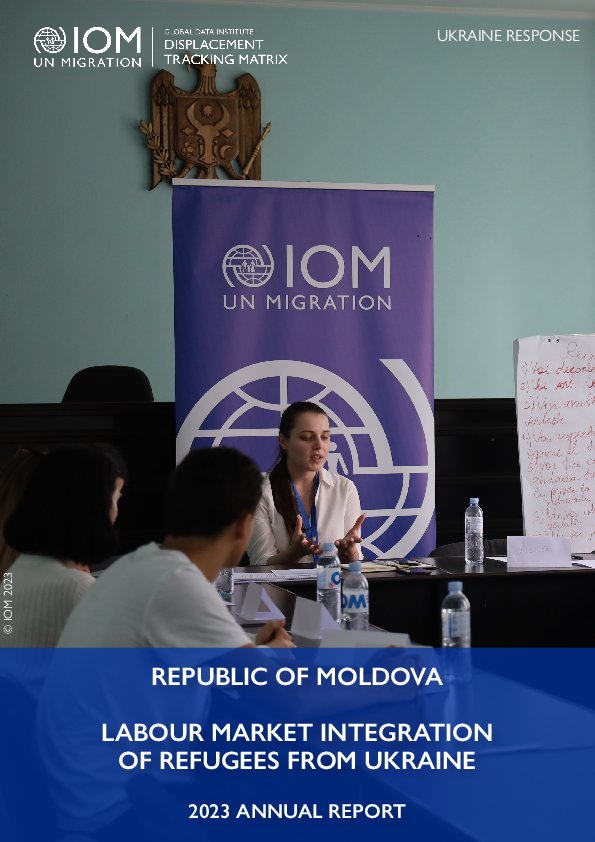
Contact
DTM Europe, DTMMediterranean@iom.int
Language
English
Location
Republic of Moldova
Period Covered
Jan 01 2023
Dec 31 2023
Activity
- Survey
Key Findings:
- Among respondents, 41 per cent are active (employed or unemployed), and 53 per cent are inactive (student status, parental leave, retirement, unemployment and not looking for a job).
- Within active population, 64 per cent are employed and 36 per cent are unemployed.
- Before displacement, 81 per cent were employed and 19 per cent were unemployed.
- Top 4 sectors of employment includes: accommodation (13%), wholesale and retail (11%), education and science (10%) and human health and social work (9%)
- Satisfaction with job and skills matching is higher among men (74%) than women (71%)
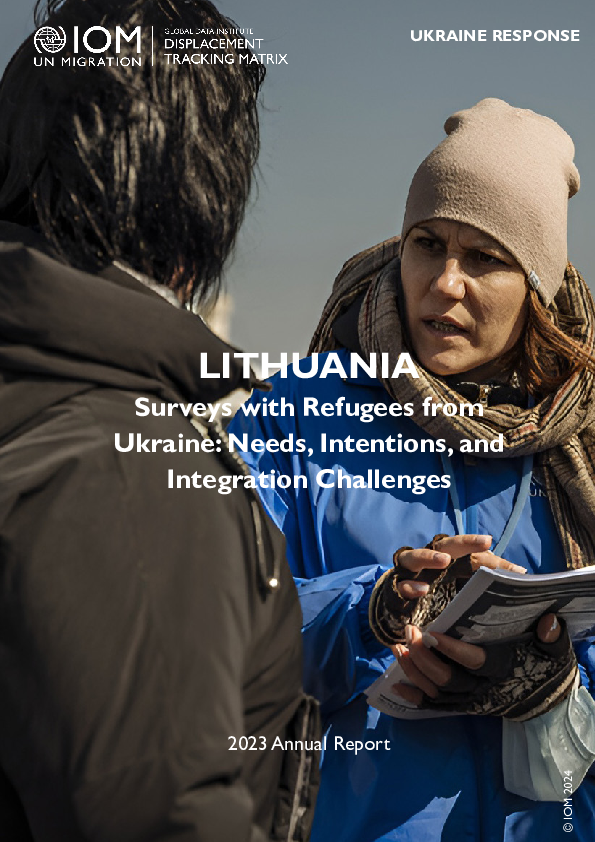
Contact
DTM Europe, DTMMediterranean@iom.int
Language
English
Location
Lithuania
Period Covered
Jan 01 2023
Dec 31 2023
Activity
- Survey
- Flow Monitoring
This report is based on a survey of displacement patterns, needs and intentions conducted by IOM’s Displacement Tracking Matrix (DTM) in the 11 countries included in the Regional Response Plan for Ukraine in 2023: 6 countries neighboring Ukraine – Belarus, Hungary, Poland, Republic of Moldova, Romania and Slovakia – and other 5 countries particularly impacted by the arrivals of refugees from Ukraine since the start of the war in February 2022 – Bulgaria, Czechia, Estonia, Latvia and Lithuania.
The analysis provided in this report is based on annual data collected from March to November 2023
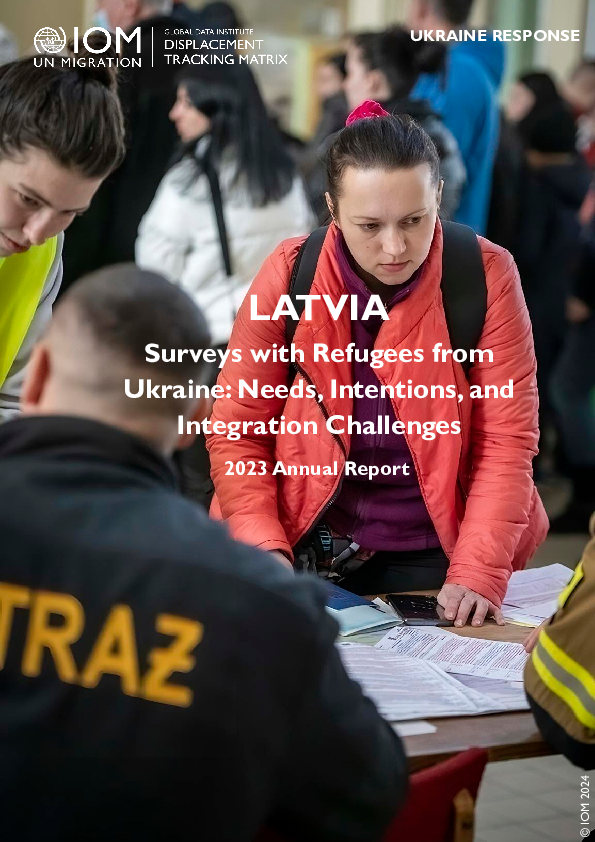
Contact
DTM Europe, DTMMediterranean@iom.int
Language
English
Location
Latvia
Period Covered
Jan 01 2023
Dec 31 2023
Activity
- Survey
- Flow Monitoring
This report is based on a survey of displacement patterns, needs and intentions conducted by IOM’s Displacement Tracking Matrix (DTM) in the 11 countries included in the Regional Response Plan for Ukraine in 2023: 6 countries neighboring Ukraine – Belarus, Hungary, Poland, Republic of Moldova, Romania and Slovakia – and other 5 countries particularly impacted by the arrivals of refugees from Ukraine since the start of the war in February 2022 – Bulgaria, Czechia, Estonia, Latvia and Lithuania.
The analysis provided in this report is based on annual data collected from January to December 2023.

Contact
DTM Europe, DTMMediterranean@iom.int
Language
English
Location
Latvia
Period Covered
Jan 01 2023
Dec 31 2023
Activity
- Survey
From January to December 2023, Displacement Tracking Matrix (DTM) gathered information on the Needs, Intentions, and Integration Challenges faced by Ukrainian refugees in Latvia, conducting interviews with a total of 1,155 individuals throughout the year. This report explores the employment profiles and prospects of the adult respondents, with a special focus on those who have either expressed an intention to stay or have already established themselves in the country (N=171). These individuals, referred to as ‘stayers’ in this study, are actively investing their human and social resources to fully integrate into the host community. The report further narrows its analysis to a subset of 155 respondents who are within the working age bracket (18-64 years old), offering insights into their involvement in the labour market and detailing their experiences, needs, and intentions concerning employment in Latvia for the duration of their displacement.

Contact
dtmukraine@iom.int
Language
English
Location
Ukraine
Snapshot Date
Mar 01 2024
Activity
- Survey
Revisions to the eligibility criteria that came into effect in March 2024 limited access to the IDP living allowance based upon a specific set of socio-economic vulnerability profiles. This introduction of additional criteria is intended to ensure that social assistance in Ukraine is capable of supporting the most vulnerable, both among those who have been displaced and the general population. However, this increases the risk of excluding some vulnerable individuals who may lose access to the IDP living allowance under the new criteria. This reduction in monthly household income could impact on the ability of vulnerable households to meet their basic needs and rebuild their lives.
The purpose of this brief is to provide an overview of the estimated share and number of IDPs that may still be eligible for the IDP allowance under the new policy. Using available secondary data, this thematic brief aims to provide an indicative overview of the share and number of IDPs that will not be eligible anymore, despite being vulnerable to a reduction in household income that could affect their ability to meet basic needs. The brief intends to inform and support advocacy and programming of humanitarian partners in complementarity with the new IDP allowance scheme.